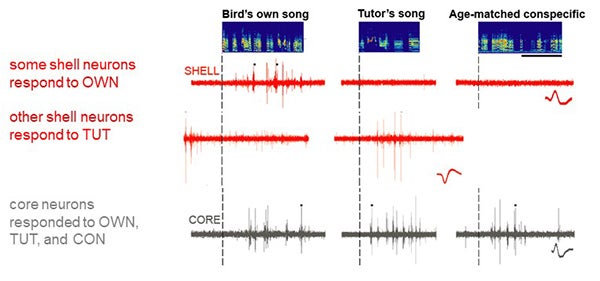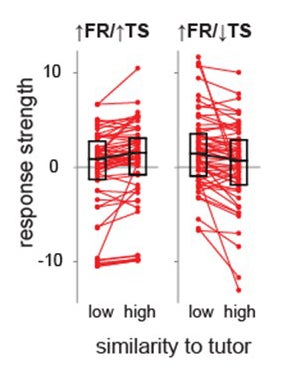I discovered a large population of neurons in LMAN-shell of anesthetized juvenile birds that show significant changes in response strength only to playback of the memorized tutor goal. Such TUT neurons are present only during early stages of sensorimotor learning, indicating that a representation of the goal is available in LMAN circuitry for a limited period. They represent a unique opportunity to exploit a subpopulation of neurons that help to encode a representation of a specific goal. Likewise, a separate subset of shell neurons show significant responses only to playback of immature self-generated sounds, indicating that these OWN neurons encode a representation of behavioral actions, and provide a substrate for comparison to the goal representation. The raw traces below show an example of a selective response to the bird’s own song (OWN) and a selective response to the tutor song (TUT). Most control songs are not shown. Here is a link to the full paper if you want to read it.

The second part of my thesis project recorded from LMAN core and shell neurons in awake juvenile birds aas they praactice and refined their song. I scored spiking activity for each utterance that juveniles produced as a function of similarity to its learned tutor song. An exciting discovery was that one group of neurons coded for high tutor similarity by increasing their firing rate, while another group of neurons encoded low tutor similarity by inreasing their firing rate. As shown below, the group of neurons on the left increased their firing rates during production of immature utterances with higher goal similarity, whereas the neurons on the right increased their firing rates during utterances with lower goal similarity.

These results can be interpreted as relative excitation for a “positive outcome” of a given motor action (left panels, good match to tutor) versus relative excitation for a “negative outcome” of a given motor action (right panels, poor match to tutor). This result suggests that increases in firing rates may represent either reinforcement (tutor-similar) or error (tutor-dissimilar) signals. The full report of these results is here.
Huan Zhao is testing the idea that the shell neurons neurons in the left panel give rise to a “direct pathway” through the basal ganglia in which high goal similarity is processed to generate a reinforcement signal, while those in the right panel give rise to an “indirect pathway” in which low goal similarity is processed to generate an error signal. See his page for further details.